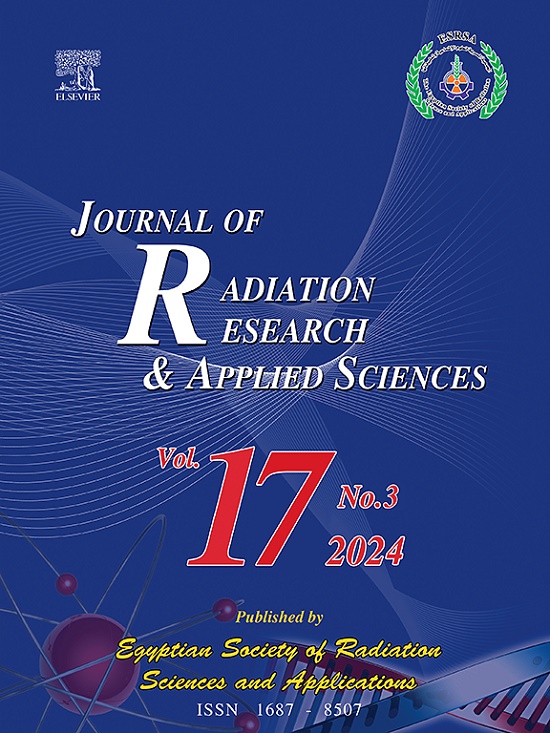Enhancing thermal transport for magnetized radiating flow of ternary nanomaterial: Thermodynamics second law analysis
IF 1.7
4区 综合性期刊
Q2 MULTIDISCIPLINARY SCIENCES
Journal of Radiation Research and Applied Sciences
Pub Date : 2025-05-09
DOI:10.1016/j.jrras.2025.101576
引用次数: 0
Abstract
Nanomaterial flows have gained considerable attention of numerous engineers and scientists now a days. It is due to significant utilization in tremendous real-life applications like nuclear reactor cooling, microelectronics, crack-resistance paint, engine cooling, heat exchangers, thermal power plants, enhance-oil recovery, transparent sunscreen, thermal transport, architecture etc. In view of such important applications, entropy optimized magnetohydrodynamic radiative flow of nanomaterial is organized. Porous space is discussed by Darcy-Forchheimer relation. Ternary hybrid nanomaterial is the hybridization of three types of nanoparticles (TiO2, SiO2 and MoS4) in base liquid (blood). Flow model is developed to discuss the thermal transport characteristics of ternary hybrid (TiO2 +SiO2 +MoS4/blood), hybrid (TiO2+SiO2/blood) and (TiO2/blood) nanomaterial. Thermal relation comprises Ohmic heating, dissipation, radiation and heat generation. Significance feature of entropy rate is addressed. Related equations of proposed model are reduced into non-dimensional expressions. Dimensionless expressions are numerically solved by utilizing ND-solve method. Comparative study for velocity, coefficient of skin friction, temperature, Nusselt number and entropy rate for three considered nanomaterials is presented. It is noted that velocity intensifies with higher curvature variable while it decays for larger magnetic field. An increasing trend of drag force is noted for higher magnetic field and curvature variable. Higher radiation variable results in temperature enhancement. Entropy rate enhances against magnetic field. An enhancement in Nusselt number is detected for higher magnetic parameter. Augmentation in heat transport rate occurs for radiation. It is observed that frictional force is higher for ternary hybrid nanofluid (TiO2 +SiO2 +MoS4 blood) when compared with hybrid nanofluid (TiO2 +SiO2 blood) and nanofluid (TiO2 blood). Here one can find that temperature and energy transport rate for ternary hybrid nanofluid (TiO2 +SiO2 +MoS4/blood) is more dominant than hybrid nanofluid (TiO2 +SiO2/blood) and nanofluid (TiO2/blood).
增强三元纳米材料磁化辐射流的热输运:热力学第二定律分析
纳米材料的流动已经引起了众多工程师和科学家的广泛关注。这是由于它在核反应堆冷却、微电子、抗裂涂料、发动机冷却、热交换器、火力发电厂、增强油回收、透明防晒霜、热传输、建筑等巨大的现实应用中的重要应用。鉴于这些重要的应用,对纳米材料的熵优化磁流体动力辐射流进行了组织。用Darcy-Forchheimer关系讨论了多孔空间。三元杂化纳米材料是将三种纳米粒子(TiO2、SiO2和MoS4)在基液(血液)中杂交而成。建立了流动模型,讨论了三元杂化(TiO2+SiO2 +MoS4/血)、杂化(TiO2+SiO2/血)和(TiO2/血)纳米材料的热输运特性。热关系包括欧姆加热、耗散、辐射和产热。讨论了熵率的显著性特征。将该模型的相关方程简化为无量纲表达式。采用nd -求解法对无量纲表达式进行数值求解。对三种纳米材料的速度、表面摩擦系数、温度、努塞尔数和熵率进行了比较研究。曲率变量越大,速度越强;磁场越大,速度越弱。随着磁场和曲率的增大,阻力有增大的趋势。较高的辐射变量导致温度增强。熵率随磁场的增大而增大。磁参数越高,努塞尔数越强。辐射的热传递率增加。观察到,与混合纳米流体(TiO2 +SiO2血)和纳米流体(TiO2血)相比,三元混合纳米流体(TiO2 +SiO2 +MoS4血)的摩擦力更高。这里可以发现,三元混合纳米流体(TiO2 +SiO2 +MoS4/血)的温度和能量输运率比混合纳米流体(TiO2 +SiO2/血)和纳米流体(TiO2/血)更占优势。
本文章由计算机程序翻译,如有差异,请以英文原文为准。
求助全文
约1分钟内获得全文
求助全文
来源期刊

Journal of Radiation Research and Applied Sciences
MULTIDISCIPLINARY SCIENCES-
自引率
5.90%
发文量
130
审稿时长
16 weeks
期刊介绍:
Journal of Radiation Research and Applied Sciences provides a high quality medium for the publication of substantial, original and scientific and technological papers on the development and applications of nuclear, radiation and isotopes in biology, medicine, drugs, biochemistry, microbiology, agriculture, entomology, food technology, chemistry, physics, solid states, engineering, environmental and applied sciences.
 求助内容:
求助内容: 应助结果提醒方式:
应助结果提醒方式:


